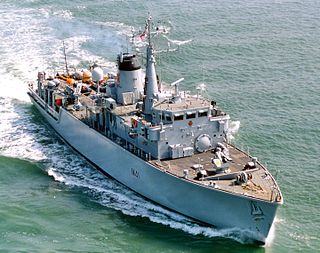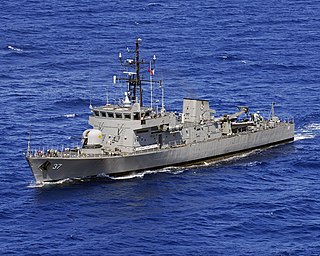
The River class is a class of offshore patrol vessels built primarily for the Royal Navy of the United Kingdom. A total of nine were built for the Royal Navy (RN), four Batch 1 and five Batch 2. One Batch 1 (HMS Clyde), which was the Falklands guard ship, was decommissioned and transferred at the end of its lease to the Royal Bahrain Naval Force.

The Hunt class is a class of thirteen mine countermeasure vessels of the Royal Navy. As built, they combined the separate roles of the traditional minesweeper and that of the active minehunter in one hull, but later modifications saw the removal of mine-sweeping equipment. They have a secondary role as offshore patrol vessels.

The Commander-in-Chief Fleet (CINCFLEET) was the admiral responsible for the operations of the ships, submarines and aircraft of the British Royal Navy from 1971 until April 2012. The post was subordinate to the First Sea Lord, the professional head of the Naval Service. In its last years, as the Navy shrank, more administrative responsibilities were added.

HMS Bronington was a Ton-class minesweeper of the Royal Navy, launched on 19 March 1953. This mahogany-hulled minesweeper was one of the last of the "wooden walls".

The Gibraltar Squadron is a unit of the British Royal Navy. It is the only seagoing Royal Naval unit based in Gibraltar, attached to British Forces Gibraltar. It currently includes two Cutlass-class fast patrol boats with a maximum speed of up to 41-knots. The squadron also uses three Pacific 24 rigid-hulled inflatable boats and deploys one diving support boat. The 2021 defence white paper indicated that henceforth, one River-class offshore patrol vessel, HMS Trent, would also be permanently based in Gibraltar for operations in the Mediterranean and in the Gulf of Guinea. As of 2023, 28 personnel were assigned to the squadron, along with additional personnel assigned to HMS Trent.

The Ton class were coastal minesweepers built in the 1950s for the Royal Navy, but also used by other navies such as the South African Navy and the Royal Australian Navy. They were intended to meet the threat of seabed mines laid in shallow coastal waters, rivers, ports and harbours, a task for which the existing ocean-going minesweepers of the Algerine-class were not suited.

HMS Caroline is a decommissioned C-class light cruiser of the Royal Navy that saw combat service in the First World War and served as an administrative centre in the Second World War. Caroline was launched and commissioned in 1914. At the time of her decommissioning in 2011 she was the second-oldest ship in Royal Navy service, after HMS Victory. She served as a static headquarters and training ship for the Royal Naval Reserve, based in Alexandra Dock, Belfast, Northern Ireland, for the later stages of her career. She was converted into a museum ship. From October 2016 she underwent inspection and repairs to her hull at Harland and Wolff and opened to the public on 1 July 2017 at Alexandra Dock in the Titanic Quarter in Belfast.
Ten ships of the Royal Navy have been named HMS Clyde after the River Clyde that runs through the city of Glasgow, Scotland. For His Majesty's Naval Base Clyde see HMNB Clyde.

HMS Saltash (J62) was a Hunt-class minesweeper of the Aberdare sub-class built for the Royal Navy during World War I. She was not finished in time to participate in the First World War and survived the Second World War to be sold for scrap in 1947.

HMS Bangor is a Sandown-class minehunter commissioned by the Royal Navy in 1999. Designed to hunt naval mines in depths of up to 200 m (660 ft) using the Sonar 2093 Variable Depth Sonar (VDS) meaning that she can conduct mine clearance operations throughout the continental shelf. She is named after the Northern Ireland seaside city of the same name, and the second Royal Navy vessel to bear the name. As of January 2024, she was the last vessel of her class in active Royal Navy service.

The Belgian Navy, officially the Naval Component of the Belgian Armed Forces, is the naval service of Belgium.

HMS Brecon was a Hunt-class mine countermeasures vessel that served with the Royal Navy. Her pennant number was M29.

The River class was a class of minesweeper built for the British Royal Navy in the 1980s, designated Fleet Minesweepers (MSF). Operated mainly by the Royal Naval Reserve they were taken out of service in 1990s and sold to foreign navies.

The Scimitar class were a class of fast patrol boat formerly in service with the British Royal Navy.
HMS Kingfisher (P260) was a Bird-class patrol vessel of the British Royal Navy.

The Peacock class is a class of patrol corvette built for the Royal Navy. Five were constructed, and by 1997 all had been sold to the Irish Naval Service or the Philippine Navy.
HMNZS Hickleton (M1131) was a Ton-class minesweeper that operated in the Royal Navy and the Royal New Zealand Navy (RNZN). She was named after a small village near Doncaster.

HMAS Doomba was a Royal Australian Navy (RAN) warship of World War II. Built for the Royal Navy around the end of World War I as the Hunt-class minesweeper HMS Wexford, the ship only saw two years of service before she was decommissioned in 1921 and sold to the Doomba Shipping Company. The vessel was renamed SS Doomba, converted into a passenger ship, and operated in the waters around Brisbane until 1939, when she was requisitioned by the RAN for wartime service. Serving first as an auxiliary minehunter, then an auxiliary anti-submarine vessel, HMAS Doomba was purchased outright by the RAN in 1940, and served until early 1946, when she was sold and converted into a linseed oil lighter. Doomba was scuttled off Dee Why, New South Wales in 1976.
In 1989 the Royal Navy was under the direction of the Navy Department in the UK Ministry of Defence. It had two main commands, CINCFLEET and Naval Home Command.














